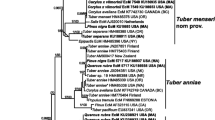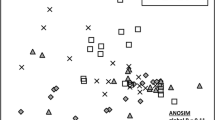Abstract
Circa 1900, a farmer from the eastern US planted 11 American chestnut (Castanea dentata) seeds on a newly established farm near West Salem in western Wisconsin. These trees were very successful, producing a large stand of over 6,000 trees. Since this area is well outside the natural range of chestnut, these trees remained free from chestnut blight until 1987. In the West Salem stand, chestnuts are the dominant species of a mixed forest community, reminiscent of the chestnut–oak ecosystems of pre-1900 Appalachia. To identify putative mycorrhizal associates of chestnut in this unique forest, our approach was twofold: (1) an extensive fruiting body survey was conducted for four seasons that yielded approximately 100 putative mycorrhizal species and (2) a belowground molecular approach was used to generate DNA sequences of the internal transcribed spacer region from ectomycorrhizae. Unexpectedly, chestnut did not appear to be the dominant underground ectomycorrhizal-forming plant species. This study highlights the need to identify the plant host species when conducting belowground molecular-based surveys and provides preliminary identification of ectomycorrhizal fungi associated with a disjunct stand of American chestnut.


Similar content being viewed by others
References
Altschul SF, Madden TL, Schäffer AA, Zhang J, Zhang Z, Miller W et al (1997) Gapped BLAST and PSI-BLAST: a new generation of protein database search programs. Nucleic Acids Res 25:3389–3402, doi:10.1093/nar/25.17.3389
Anagnostakis SL (2001) The effect of multiple importations of pests and pathogens on a native tree. Biol Invasions 3:245–254, doi:10.1023/A:1015205005751
Anagnostakis SL, Hillman B (1992) Evolution of the chestnut tree and its blight. Arnoldia 52:3–10
Bridge PD, Roberts PJ, Spooner BM, Panchal G (2003) On the unreliability of published DNA sequences. New Phytol 160:43–48, doi:10.1046/j.1469-8137.2003.00861.x
Brown JH, Woods FW (1968) Root extension of trees in surface soils of the North Carolina piedmont. Bot Gaz 129:126–132, doi:10.1086/336424
Cullings KW, Vogler DR, Parker VT, Finley SK (2000) Ectomycorrhizal specificity patterns in a mixed Pinus contorta and Picea engelmannii forest in Yellowstone National Park. Appl Environ Microbiol 66:4988–4991, doi:10.1128/AEM.66.11.4988-4991.2000
Dahlberg A (2001) Community ecology of ectomycorrhizal fungi: an advancing interdisciplinary field. New Phytol 150:555–562, doi:10.1046/j.1469-8137.2001.00142.x
Dickie IA, Koide RT, Fayish AC (2001) Vesicular-arbuscular mycorrhizal infection of Quercus rubra seedlings. New Phytol 151:257–264, doi:10.1046/j.1469-8137.2001.00148.x
Dulmer KM (2006) Mycorrhizal associations of American chestnut seedlings: a lab and field bioassay. MS thesis, College of Environmental Science and Forestry, State University of New York
Feibelman T, Bayman P, Cibula WG (1994) Length variation in the internal transcribed spacer of ribosomal DNA in chanterelles. Mycol Res 98(6):614–618
Gardes M, Bruns TD (1993) ITS primers with enhanced specificity of basidiomycetes: application to the identification of mycorrhizae and rusts. Mol Ecol 2:113–118, doi:10.1111/j.1365-294X.1993.tb00005.x
Gardes M, Bruns TD (1996) Community structure of ectomycorrhizal fungi in a Pinus muricata forest: above- and below-ground views. Can J Bot 74:1572–1583, doi:10.1139/b96-190
Giomaro G, Sisti D, Zambonelli A, Amicucci A, Cecchini M, Comandini O et al (2002) Comparative study and molecular characterization of ectomycorrhizas in Tilia americana and Quercus pubescens with Tuber brumale. FEMS Microbiol Lett 216:9–14, doi:10.1111/j.1574-6968.2002.tb11407.x
Glen M, Tommerup IC, Bougher NL, O’Brien PA (2001) Interspecific and intraspecific variation of ectomycorrhizal fungi associated with Eucalyptus ecosystems as revealed by ribosomal DNA PCR–RFLP. Mycol Res 105(7):843–858, doi:10.1017/S095375620100418X
Horton TR, Bruns TD (1998) Multiple-host fungi are the most frequent and abundant ectomycorrhizal types in a mixed stand of Douglas fir (Pseudotsuga menziesii) and bishop pine (Pinus muricata). New Phytol 139:331–339, doi:10.1046/j.1469-8137.1998.00185.x
Horton TR, Bruns TD (2001) The molecular revolution in ectomycorrhizal ecology: peeking in to the black-box. Mol Ecol 10:1855–1871, doi:10.1046/j.0962-1083.2001.01333.x
Horton TR, Cazares E, Bruns TD (1999) Ectomycorrhizal, vesicular-arbuscular and dark septate fungal colonization of bishop pine (Pinus muricata) seedlings in the first 5 months of growth after wildfire. Mycorrhiza 8(1):11–18, doi:10.1007/s005720050205
Izzo AD, Agbowo J, Bruns TD (2005) Detection of plot-level changes in ectomycorrhizal communities across years in an old-growth mixed-conifer forest. New Phytol 166:619–630, doi:10.1111/j.1469-8137.2005.01354.x
Kårén O, Hogberg N, Dahlberg A, Jonsson L, Nyland J (1997) Inter- and intraspecific variation in the ITS region of rDNA of ectomycorrhizal fungi in Fennoscandia as detected by endonuclease analysis. New Phytol 136:313–325, doi:10.1046/j.1469-8137.1997.00742.x
Kennedy PG, Izzo AD, Bruns TD (2003) There is high potential for the formation of common mycorrhizal networks between understory and canopy trees in a mixed evergreen forest. J Ecol 91:1071–1080, doi:10.1046/j.1365-2745.2003.00829.x
Kernaghan G, Widden P, Bergeron Y, Le’gare S, Pare D (2003) Biotic and abiotic factors affecting ectomycorrhizal diversity in boreal mixed-woods. Oikos 102:497–504, doi:10.1034/j.1600-0706.2003.12415.x
Kormanik PP, Schultz RC, Bryan WC (1982) The influence of vesicular–arbuscular mycorrhizae on the growth and development of eight hardwood tree species. For Sci 28(3):531–539
Kõljalg U, Larsson KH, Abarenkov K, Nilsson RH, Alexander IJ, Eberhardt U et al (2005) UNITE: a database providing web-based methods for the molecular identification of ectomycorrhizal fungi. New Phytol 166:1063–1068, http://unite.ut.ee/10.1111/j.1469-8137.2005.01376.x
Marx DH (1979) Synthesis of Pisolithus ectomycorrhizae on pecan seedlings in fumigated soil. USDA Forest Service, Res note SE-283, SFES Asheville, NC
McEwan RW, Keiffer CH, McCarthy BC (2006) Dendroecology of American chestnut in a disjunct stand of oak–chestnut forest. Can J Res 36:1–11, doi:10.1139/x05-218
Michelangeli FA, Penneys DA, Giza J, Soltis D, Hils MH, Skean JD Jr (2004) A preliminary phylogeny of the tribe Miconieae (Melastomataceae) based on nrITS sequence data and its implications on inflorescence position. Taxon 53:279–290, doi:10.2307/4135608
Molina R, Massicotte H, Trappe JM (1992) Specificity phenomena in mycorrhizal symbioses: community-ecological consequences and practical implications. In: Allen MF (ed) Mycorrhizal functioning: an integrative plant–fungal process. Chapman and Hall, New York, pp 357–423
Neville J, Tessier JL, Morrison I, Scarratt J, Canning B, Klironomos JN (2002) Soil depth distribution of ecto- and arbuscular mycorrhizal fungi associated with Populus tremuloides within a 3-year-old boreal forest clear-cut. Appl Soil Ecol 19:209–216, doi:10.1016/S0929-1393(01)00193-7
O’Brien HE, Parrent JL, Jackson JA, Moncalvo JM, Vilgalys R (2005) Fungal community analysis by large-scale sequencing of environmental samples. Appl Environ Microbiol 71(9):5544–5550, doi:10.1128/AEM.71.9.5544-5550.2005
Paillet FL, Rutter PA (1989) Replacement of native oak and hickory tree species by the introduced American chestnut (Castanea dentata) in southwestern Wisconsin. Can J Bot 67:3457–3469
Richard F, Millot S, Gardes M, Selosse MA (2005) Diversity and specificity of ectomycorrhizal fungi retrieved from an old-growth Mediterranean forest dominated by Quercus ilex. New Phytol 166:1011–1023, doi:10.1111/j.1469-8137.2005.01382.x
Rhoades CC, Brosi SL, Dattilo AJ, Vincelli P (2003) Effect of soil compaction and moisture on incidence of Phytophthora root rot on American chestnut (Castanea dentata) seedlings. For Ecol Manage 184:47–54, doi:10.1016/S0378-1127(03)00147-6
Schwadron PA (1995) Distribution and persistence of American chestnut sprouts, Castanea dentata (Marsh.) Borkh., in northeastern Ohio woodlands. Ohio J Sci 95(4):281–288
Taberlet P, Gielly L, Pautou G, Bouvet J (1991) Universal primers for amplification of three non-coding regions of chloroplast DNA. Plant Mol Biol 17:1105–1109, doi:10.1007/BF00037152
Taylor AFS (2002) Fungal diversity in ectomycorrhizal communities: sampling effort and species detection. Plant Soil 244:19–28, doi:10.1023/A:1020279815472
Tedersoo L, Koljalg U, Hallenberg N, Larsson K-H (2003) Fine scale distribution of ectomycorrhizal fungi and roots across substrate layers including coarse woody debris in a mixed forest. New Phytol 159:153–165, doi:10.1046/j.1469-8137.2003.00792.x
Tedersoo L, Hansen K, Perry BA, Kjoller R (2006) Molecular and morphological diversity of pezizalean ectomycorrhiza. New Phytol 170:581–596, doi:10.1111/j.1469-8137.2006.01678.x
Vandenkoornhuyse P, Baldaut SL, Leyval C, Straczek J, Young JPW (2002) Extensive fungal diversity in plant roots. Science 295:2051, doi:10.1126/science.295.5562.2051
Vilgalys R (2003) Taxonomic misidentification in public DNA databases. New Phytol 160:4–5, doi:10.1046/j.1469-8137.2003.00894.x
Walker JF, Miller OKJ, Horton JL (2008) Seasonal dynamics of ectomycorrhizal fungus assemblages on oak seedlings in the southeastern Appalachian Mountains. Mycorrhiza 18:123–132, doi:10.1007/s00572-008-0163-8
White TJ, Bruns TD, Lee SB, Taylor JW (1990) Amplification and direct sequencing of fungal ribosomal RNA genes for phylogenetics. In: Innis MA, Gelfand DH, Sninsky JJ, White TJ (eds) PCR protocols—a guide to methods and applications. Academic, New York, p 31
Acknowledgements
We would like to thank the Dolores Rhyme and Ron Bockenhauer families for allowing access to the West Salem chestnut site. We thank Daniel Kinney, Sean Westmoreland, Nik Zitomer, Adam Gusse, Kelsea Jewel, and Bernadette O’Reilly, participants of the 2001 Smith foray and 2005 NAMA foray, for their help with collections, especially Andrew Methven, Karen Nakasone, James Scott, Rosanne Healy, Bart Buyck, Patrick Leacock, Wyatt Gaswick, and Heather Hallen-Adams. Michael Abler and Meredith Thomsen reviewed an earlier version of this manuscript. This work was partially funded by the American Chestnut Foundation and the Graduate Student Research Service and Education Leadership Grant Program at the University of Wisconsin-La Crosse.
Author information
Authors and Affiliations
Corresponding author
Electronic Supplementary Material
Below is the link to the Electronic supplementary material
Table S1
Fruiting body collections of putatively mycorrhizal species from the West Salem chestnut stand and their sequence accession numbers. (DOC 143 kb)
Rights and permissions
About this article
Cite this article
Palmer, J.M., Lindner, D.L. & Volk, T.J. Ectomycorrhizal characterization of an American chestnut ( Castanea dentata )-dominated community in Western Wisconsin. Mycorrhiza 19, 27–36 (2008). https://doi.org/10.1007/s00572-008-0200-7
Received:
Accepted:
Published:
Issue Date:
DOI: https://doi.org/10.1007/s00572-008-0200-7




